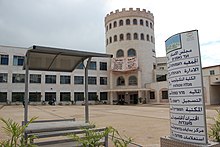Baqa al-Gharbiyye
In 2003, Baqa al-Gharbiyye united with the Jatt local council to form Baqa-Jatt, a unification that was dissolved a few years later.
[3] An olive press, quarries and a winepress believed to date to the Hellenistic or Early Roman period have been found.
[citation needed] In 1596, Baqa al-Gharbiyye appeared in Ottoman tax registers as being in the Nahiya of Jabal Shami, part of the Sanjak of Nablus.
It had a population of 5 Muslim households who paid a fixed tax rate of 33.3% on wheat, barley, summer crops, goats or beehives, and a press for olives or grapes; a total of 12,000 akçe.
[11] In 1870, the French explorer Victor Guérin described the village as built on a low hill with wells and cisterns that looked ancient.
[14] In the 1922 census of Palestine conducted by the British Mandate authorities, Baqa Gharbiyeh had a population of 1,443; 1442 Muslim[15] and one Anglican Christian.
Members of the older generation say men, women and children threw stones and rocks at the camp to free those who were arrested.
[26] As the Israeli foreign minister in April and June 2008, Tzipi Livni raised the possibility of territorial exchange with Palestinian Authority President Mahmoud Abbas.
She proposed transferring Israeli Arab communities, among them Baqa al-Gharbiyeh, to the Palestinian side of the border.
Today, its residents have diverse backgrounds, including families with roots tracing back to Egypt and Persia.
The Al-Qasemi Academic College of Education is open to students from around the country, and has a combined Arab and Jewish faculty.
The mayors also committed to protecting the mountain aquifer, the most important underground water source for Israelis and Palestinians, by establishing an authorized sewage grid-system.




